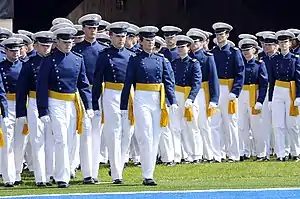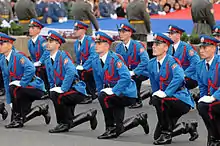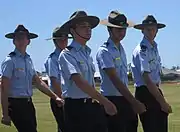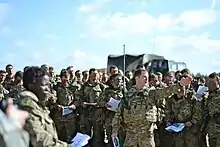Cadet
A cadet is an officer trainee or candidate. The term is frequently used to refer to those training to become an officer in the military,[1] often a person who is a junior trainee. Its meaning may vary between countries.


Usage by country
Antigua and Barbuda
The Antigua and Barbuda Cadet Corps consists of students between the ages of 12 and 19. It Is a voluntary youth organization, sponsored by the government and people of Antigua & Barbuda that acquires its membership from the Secondary School. The main objective is to provide training and personal development to the youths through paramilitary activities and also embrace community activities. The training is geared to inspire young men and woman to become model citizens. Emphasis during training is often based on discipline, loyalty, leadership and good citizenry.
Presently, the cadet corps has 200 active members and falls under the direct command of Colonel Glyne V. Dunnah, a regular officer of the Antigua and Barbuda Defense Force (ABDF), and is a part of the ABDF.[2] There are two categories in the Cadet Corps: Sea Cadets and Infantry Cadets. Ranks start from Recruit—WNCO.
Australia

In Australia, a cadet is an officer in training. The official rank is Officer Cadet (OCDT for members of the Australian Regular Army and OFFCDT for members of the Royal Australian Air Force), however OCDTs in the Royal Military College—Duntroon are referred to as staff cadet (Scdt) for historical reasons. A "cadet" can be a person aged between 12.5 and 19 who is a member of the Australian Defence Force Cadets (ADFC). The ADFC is composed of the Australian Army Cadets (AAC), Australian Navy Cadets (ANC), and Australian Air Force Cadets (AAFC), which are funded by the Australian Government via the Department of Defence.[3]
Other cadet movements include the St John Ambulance Cadets, and the South Australian Country Fire Service Cadets. The longest running cadet corps in Australia is The King's School Cadet Corps.
UK

In Commonwealth countries, including the United Kingdom, the rank of Cadet is first rank of the cadet forces, higher ranks also contain the word cadet such as Cadet Flight Sergeant used in the Air Training Corps however in practice they are often referred to as Flight Sergeant, the same being true for the other ranks. In the United Kingdom these are the Combined Cadet Force, the Sea Cadet Corps, the Army Cadet Force, the Air Training Corps, Fire Cadets, Police Cadets, and St John Ambulance Cadets. Officers in training at one of the UK's officer training schools, these are Britannia Royal Naval College for the Royal Navy, Commando Training Centre Royal Marines for the Royal Marines, Royal Military Academy Sandhurst for the British Army and Royal Air Force College Cranwell for the Royal Air Force, as well as students part of the Defence Technical Undergraduate Scheme, have the rank of Officer Cadet.
Canada

In Canada, the term "cadet" refers to an officer in training, with the official rank names as Officer Cadet for the Air Force and Army and Naval Cadet for the Navy.
It also refers to any member of the Royal Canadian Army Cadets, Royal Canadian Air Cadets or Royal Canadian Sea Cadets. These three organizations are volunteer youth groups administered by the Department of National Defence. The program is sponsored by the Canadian Forces and funded through the Department of National Defence (DND) in partnership with the Army Cadet, Air Cadet, and Navy Leagues of Canada.
The term Cadet Movement applies when speaking of everyone associated with the program including the CF, DND, Leagues, Community Sponsors, Cadets, and parents and guardians of cadets.
Although cadets in other countries may have to take part in the military in their country, cadets in Canada do not have to join the Canadian Armed Forces. The Canadian cadet organization is the largest youth organization in Canada and the largest Cadet group in the world.
The Royal Canadian Mounted Police used to maintain police cadet partnership with Scouts Canada called the RCMP Rovers and Ventures; however, it has been re-constituted into the RCMP Stetsons and Spurs and is run by various RCMP detachments.
Germany
In Germany, the rank cadet (German: Seekadett) only exists in the German Navy for officers in training. In the Army and the Luftwaffe, officers in training usually have the rank of a Fahnenjunker or ensign (German: Fähnrich) before they are promoted into the rank of a lieutenant.
Philippines
In the Philippines, the term cadet is used in mostly military attached organizations, but it is more distinctive in the service academies of the Philippines, [e.g., the Philippine Military Academy (PMA), the Philippine National Police Academy (PNPA), Philippine Merchant Marine Academy (PMMA), Maritime Academy of Asia and the Pacific (MAAP) and Aerospace Cadets of the Philippines (ACP)]. Graduates of these service academies are automatically given officer commissions in the Armed Forces of the Philippines, the Philippine National Police, Philippine Coast Guard, the Bureau of Fire Protection, and Bureau of Jail Management and Penology. Graduates of PMMA are given reserve officer status in the Philippine Navy and mostly go to private shipping firms. The term cadet is also applicable to the enrollees of Citizen's Army Training (for high school) and Reserve Officer Training Corps (for college). Service academy cadets are thought to be between the NCO and officer ranks, and NCO consider cadets as rank higher to them. Punishments for the cadets depends on their violations. If a cadet violated the rules and regulations of Philippine Military Training and the rules of the school itself, the cadet will get punished by either doing push-ups, pumping, or squat.
Cadet vs Officer Candidate
The words cadet and officer candidate are synonymous in referring the rank below second lieutenant. In the Philippines, officer candidates are referred to RESCOM, AFPOCS and PCGOBETC students who had baccalaureate degree, foreign service academies and reserve officer pools[4] undergoing 4 months to 1 year of rigorous military training.[5][6] On the other hand, cadets are referred to students of military schools undergoing 4 years of military training while completing their college degree.[7]
Ireland
In Ireland, a cadet is a pupil of the military college, which carries out officer training for the Air Corps, Army and Naval Service. Training takes two years and the cadets are split into senior and junior grades and classes.
Norway
In Norway, a "cadet" is a pupil of either of the three Krigsskolen ("war schools"), which educate commanding officers for either the Army, the Navy or to the Air Force.
United States
In the United States, cadet refers to a full-time college student who is concurrently in training to become a commissioned officer of the armed forces. Students at the United States Military Academy, the United States Air Force Academy, and the United States Coast Guard Academy respectively hold the rank of Cadet, United States Army; Cadet, United States Air Force; and Cadet, United States Coast Guard, while students in the Army Reserve Officer Training Corps (AROTC) and the Air Force Reserve Officer Training Corps (AFROTC) respectively hold the rank of Cadet, United States Army Reserve; and Cadet, United States Air Force Reserve. In contrast, students at the United States Naval Academy and those enrolled in the Naval Reserve Officer Training Corps (NROTC) at civilian colleges and universities are referred to as "midshipman" (plural: "midshipmen") vice cadet and hold Midshipman rank in the United States Navy and United States Naval Reserve, respectively.
Students at the United States Merchant Marine Academy and the preponderance of students at the Maine Maritime Academy, the Massachusetts Maritime Academy, the California Maritime Academy and the State University of New York Maritime College, though called cadets at their respective institutions, actually hold the rank of Midshipman, United States Merchant Marine Reserve, United States Naval Reserve. Some state-sponsored military colleges, including The Citadel, Virginia Military Institute (VMI) and private military colleges, Wentworth Military Academy (WMA, closed in 2017, but still having an "OLD BOY" FaceBook page and museum,) Norwich University (NU), refer to their students as cadets, or have lists of corps of cadets.
Students enrolled in military-themed secondary education academies or school programs (JROTC) are also referred to as cadets.
Austria-Hungary
In Austria-Hungary, the cadets of the Austro-Hungarian Army (1867–1918) wore the Feldwebel rank insignia on the gorget patch.
The characteristic of the cadet ranks was the so-called distinction-galloon on the sleeve ends. It was similar to the feldwebel-galloon, however, from gold colour instead of emperor-yellow. The particular rank was added as well.
- See also
| Designation | Cadet officer-deputy until 1908 | Fähnrich 1908-1918 | ||
|---|---|---|---|---|
 |
 |
 |
 | |
| Rank insignia collar | ||||
| Rank description | Kadett-Offizierstellvertreter | Fähnrich | ||
| (Hungarian) | (Hadapród-Tiszthelyettes) | (Zászlós) | ||
Bangladesh
In Bangladesh, the students of cadet colleges, MCSK (Military Collegiate School Khulna) and who are volunteering Bangladesh National Cadet Corps are called cadets. The students of Bangladesh Marine Academy are also called Engineering Cadets or Officer Cadets. The recruits of the Bangladesh Army, Bangladesh Navy and Bangladesh Air Force are called Gentleman Cadets (GC).
There are 12 Cadet Colleges in Bangladesh, nine for men and three for women. Faujdarhat Cadet College is the first cadet college of the country, established in 1958.
In addition, the students of MCSK (Military Collegiate School Khulna), an English version educational institution under the direct supervision of Bangladesh army are also addressed as cadets. It has an administrative structure as like the other regular cadet colleges and trains its cadets with primary paramilitary training.
Voluntary members of Bangladesh National Cadet Corps (BNCC) are also called cadets in Bangladesh. They promote youth development movements in Bangladesh.
Bangladesh National Cadet Corps (BNCC) is a voluntary organization for teachers and students. It is one of the oldest organisations in Bangladesh. It started its operation in the Indian sub continent in the year 1923 as University Officers Training Corps (UOTC).
During the Bangladesh Liberation War, cadets of this organisation played an important role as freedom fighters, with a number of casualties. The cadets aspire to show the same devotion. This is one of the most motivated forces existing in Bangladesh, operating under the dual administration of the Ministry of Defence (MoD) and the Ministry of Education (MoE). Its main objective is to develop leadership qualities, sense of dedication and patriotism among the members through military based principles. Another mission is to prepare a 2nd or 3rd line of reserve forces having the capabilities to operate with the regular armed forces to counter any emergencies or in the wake of external aggression.
Bangladesh National Cadet Corps (BNCC) is the apex organisation that provides Voluntary Military Training (VMT) to the students of as BNCC cadets to build good character and attempts to instil dedicative, patriotic and leadership qualities. In military academies, cadets are trained in isolation to make them efficient military leaders to lead the soldiers of the Bangladesh Armed Forces as officers. But BNCC cadets are basically students of the universities, colleges and high schools who voluntarily join the corps to develop themselves as good citizens of the country and also enjoy the incentives provided by BNCC. Cadets take military training voluntarily twice a week during school hours within the premises of their respective institutions and some intensive training during the Annual Training Exercise and collective exercise with the Bangladesh Armed Forces.
Finland
The National Defence University Finland educates all officers in Finnish military. All students serve as cadets under the Cadet School for the first year and then either in Navy Academy, Air Academy or one of Army Academy's schools as cadets or holding an upper cadet rank (i.e. sergeant cadet).
Prussia and Imperial Germany (1871–1899)
The Prussian military system created a caste of gentlemen-cadets called Junkers (from Jung Herr, "Young Lord"). Their family would receive a title and a land grant in exchange for service in the Army. When their sons became of age (about 14 or so), they would be sent off to either a military academy (Kadettenschule) or apply directly to a regiment. Both required that the candidate be sponsored by a colonel or general, come from a respectable family, have the means to support their livelihood, and have no outstanding debts. New cadets were classed as a Fahnenträger ("Flag-bearer") if they had already attended an academy or Offizier-Aspirant ("Officer Candidate") if they had not. Later the title was changed to Portepee Fähnrich ("Cadet with lanyard"); they received the right to wear a senior NCO's lanyard knot on their service dagger.
After six months to a year, they were promoted to Fähnrich (Officer cadet). They were later renamed Degen Fähnrich ("Sword Officer cadets"), who received the sword of an officer. They were considered probationary officers. The officer cadet was allowed to eat in the officer's mess and have a Offiziersbursche (enlisted servant). After a probationary period the officer cadet would submit a request to be commissioned. The officers of the regiment they were assigned to would vote on whether they deserved a commission. Those who passed the vote would have their names submitted by their colonel to the Kaiser, who would approve their promotion to Leutnant (OF-1).
Ghana
The National Cadet Corps (Ghana) (NCCG) of Ghana is an amalgamation of Army (GA), Navy (GN), Air Force (GHF), Police (GPS) and the Fire (GNFRS) Cadets in Ghana. It came into establishment in 2002 under the ministry of education, presently Ministry of Youth and Sports.
Hong Kong
Three cadet corps are linked to Hong Kong colonial past:
- Hong Kong Sea Cadet Corps
- Hong Kong Adventure Corps
- Hong Kong Air Cadet Corps
- Hong Kong Army Cadets Association Limited
They are now funded by the Hong Kong government and has no ties to either the British Forces or the PLA.
Jamaica
The Cadet Force came into being on November 1, 1943, and was then known as the Army and Air Cadet Force. The creation of the Force was instigated by the then Officer Commanding (OC) Troops – Brigadier T. Denis DALY, M.C; the then Garrison Commander – Colonel C. W. M. FIRTH, M.C; the then Director of Education – Hon. B. H. EASTER, C.M.G, C.B.E. and the first Commandant of the Cadet Force in Jamaica - Colonel Michael Ralph de CORDOVA, CBE, ED, JP (then Major Michael Ralph de CORDOVA, M.B.E) who evolved the organization, rules and regulations and also designed its badge and heraldry. Prior to this date, one or two schools had training Units (Army Training Corps), but by the end of November 1943, Cadet Units were formed in sixteen (16) different schools, colleges, and training centres, and the Force was organized with an establishment of 46 Officers and 1,068 Cadets under the command of then Lt Col M. R. de CORDOVA.
India
In India, the National Cadet Corps is a voluntary cadet organization for motivating college students to pursue a career in the Indian Armed Forces. It aims to develop qualities of character, discipline, teamwork, leadership and adventure in the students. The corps organizes outdoor activities, such as camping, trekking, mountain climbing, etc. besides providing small arms training to cadets. Cadets have no commitment for serving in the armed forces, but are given a preference by the Services Selection Board when applying for officer commissions in the military services.
Cadet is also used as a rank for those enrolled in military academies of India, such as the National Defence Academy, Indian Military Academy, Indian Naval Academy, Air Force Academy, Indian Coast Guard Academy or Armed Forces Medical College (India). These cadets are commissioned as officers in the respective service upon graduation, and make a commitment to serve. The term Gentleman Cadet is used to refer to Indian Military Academy trainees.
Indonesia
In the service academies of Indonesia which includes (Military, Naval, and Air Force) also with the Police Academy, cadets are called Taruna for military academy cadets, Kadet for naval academy cadets, and Karbol for air force academy cadets in Indonesian. Police academy cadets are also called Taruna.
For recruits or trainee who are training to be soldiers or police personnel in the enlisted ranks, the term is called Siswa which literally means "student", it also refers to students who are studying in military high schools and other training institutions.
Netherlands

The Royal Military Academy (Dutch: Koninklijke Militaire Academie or KMA) is the service academy for the Dutch Army, the Dutch Air Force, and the Royal Marechaussee. Located in Breda, the Netherlands, the KMA has trained future officers since 1828. All students serve as cadet or holding an upper cadet rank (i.e. cadet-sergeant)
Students of the Dutch Royal Naval College (Dutch: Koninklijk Instituut voor Marine or KIM), the service academy for the Royal Netherlands Navy, including the Netherlands Marine Corps do not serve as cadet, but as adelborst, the Dutch term for midshipman, or holding an upper adelborst rank (i.e. sergeant-adelborst).
Both cadets and adelborsts are addressed as “jonker” (derived from “jonge heer” ("young lord") ).
New Zealand
In New Zealand, the cadet forces comprises the Sea Cadet Corps (SCC), the New Zealand Cadet Corps (NZCC), and the Air Training Corps (ATC). All three corps are part of the umbrella organisation of the New Zealand Cadet Forces.
Pakistan
Pakistan has a strong line of cadet colleges throughout the country. Cadet Colleges are special school system of the Pakistan Armed Forces that act as feeder schools for the services officer training academies of the Pakistan Army, Navy and Air Force. They are specifically intended to prepare young students from a very broad range of socioeconomic and linguistic backgrounds to pass the demanding physical, educational, psychological and behavioural standards of the Inter Services Selection Board (ISSB). This is distinct from the purpose of regular cantonment schools intended to educate the children of service members. The expansion of the Pakistan armed forces, and the broadening of the social base of its officers corps from the 1960s onwards has inevitably led to the expansion in the number of cadet colleges and their distribution around the country.
Singapore
In Singapore, there are three national cadet forces, the National Cadet Corps, the National Police Cadet Corps (NPCC), and the National Civil Defence Cadet Corps (NCDCC). Secondary school students who are members of these three organisations are called 'cadets'.
In NPCC and NCDCC, the rank of Cadet is below the rank of Lance Corporal.[8][9] For NPCC, Secondary One students officially attain the rank of Cadet at their Area's Swearing-In Ceremony. Cadets do not bear any rank insignia; however, the letters 'NPCC' and 'NCDCC' are at the bottom of the rank to differentiate NPCC and NCDCC Cadets from Singapore Police Force and Singapore Civil Defence Force personnel respectively.
Sri Lanka
In Sri Lanka, there is one primary cadet force which is the National Cadet Corps (NCC). In recent years the NCC developed an Air Force Wing, a Naval Wing and a Police Wing. Western Cadet Bands and Eastern Cadet Bands The National Cadet Corps (Sri Lanka) is the Sri Lankan military cadet corps and is a Ministry of Defence sponsored youth organisation in Sri Lanka. Formally the Ceylon Cadet Corps since 1881. It is open to high school students on voluntary basis and has a history of more than 126 years. The officers are teachers who act as instructors. The Cadets are given basic military training in small arms and parades. The officers and cadets have no liability for active military service but many volunteer to join the armed forces.
See also
References
-
 One or more of the preceding sentences incorporates text from a publication now in the public domain: Chisholm, Hugh, ed. (1911). "Cadet". Encyclopædia Britannica (11th ed.). Cambridge University Press.
One or more of the preceding sentences incorporates text from a publication now in the public domain: Chisholm, Hugh, ed. (1911). "Cadet". Encyclopædia Britannica (11th ed.). Cambridge University Press. - Antigua and Barbuda Defense Force.
- "AAFC". AAFC. 2018. Retrieved 22 April 2020.
- "PNoy thanks AFP-OCS, swipes at critics". Manila Standard. Retrieved 2020-07-03.
- Inquirer, Philippine Daily (2014-02-23). "No PMA clique in AFP, says chief of staff". INQUIRER.net. Retrieved 2020-07-03.
- Romero, Alexis. "Noy attends non-PMA officers' graduation". philstar.com. Retrieved 2020-07-03.
- Share; Twitter; Twitter; Twitter. "ROTC infuses balance in PH military: prof". www.pna.gov.ph. Retrieved 2020-07-03.
- "National Civil Defence Cadet Corps (NCDCC) / National Civil Defence Cadet Corps (NCDCC)". www.uniforminsignia.org. Retrieved 2018-11-20.
- "National Police Cadet Corps". www.npcc.org.sg. Retrieved 2018-11-20.
- Tayob, Abdulkader (24 February 1995). Islamic Resurgence in South Africa: The Muslim Youth Movement. Juta and Company Ltd. ISBN 9780799216127. Retrieved 24 February 2018 – via Google Books.
- admin. "Cadets". greyhighschool.com. Archived from the original on 24 February 2018. Retrieved 24 February 2018.
- http://www.dod.mil.za/sasoldier/2012/soldmar%2012cs5ss.pdf
External links
- Volunteer Cadet Corps (Royal Naval and Royal Marines Cadets)
- Online community for cadets in UK!
- EtymologyOnLine
- United States Army Cadet Corps
- Army Cadets in Exeter & East Devon
- United States Naval Sea Cadet Corps
- UK Sea Cadet Corps
- iPoliceCadet.com
- New Zealand Cadet Forces
- Canadian Cadet Movement
- Web Cadet Corps: Online International Cadet Organization circa 1996
- Australian Cadet Site
- Civil Air Patrol
- Swiss Cadets Association
- Swiss Verkehrskadetten Association
- Alpha Company Royal Marines Cadets